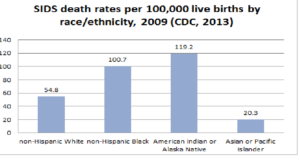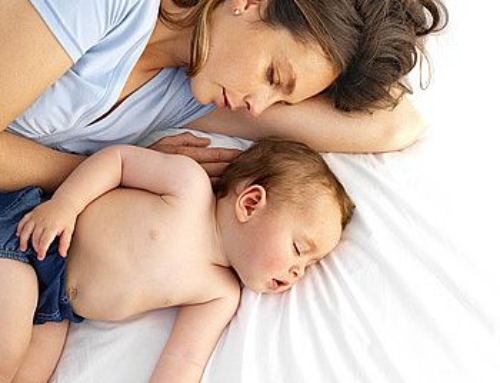 Public health initiatives for newborns often focus on Sudden Infant Death Syndrome (SIDS, which is considered one element of Sudden Unexplained Infant Deaths, or SUDI) given the catastrophic consequences. New parents are often given lots of information about what they can do to reduce their risk of SIDS despite the fact that we still lack a full understanding of what exactly happens when these children die. Various risk factors have emerged over the years and have gotten some attention, including formula use, prematurity, low birth weight, sleeping prone, parental smoking, parental drug and alcohol use, and of course, bedsharing. (In a recent analysis[1], however, bedsharing was found not to be a risk factor, but rather a factor that overlaps with those linked to being part of a marginalized group and that other factors linked to this marginalization is what increases the risk of SIDS.)
Public health initiatives for newborns often focus on Sudden Infant Death Syndrome (SIDS, which is considered one element of Sudden Unexplained Infant Deaths, or SUDI) given the catastrophic consequences. New parents are often given lots of information about what they can do to reduce their risk of SIDS despite the fact that we still lack a full understanding of what exactly happens when these children die. Various risk factors have emerged over the years and have gotten some attention, including formula use, prematurity, low birth weight, sleeping prone, parental smoking, parental drug and alcohol use, and of course, bedsharing. (In a recent analysis[1], however, bedsharing was found not to be a risk factor, but rather a factor that overlaps with those linked to being part of a marginalized group and that other factors linked to this marginalization is what increases the risk of SIDS.)
One factor that has existed in the literature but is not as well-known, but is terrifying for those who do hear about it, is daycare. It isn’t too surprising that it fails to be mentioned given that much of the public discussion on SIDS takes place in the USA, a location with no paid maternity leave and minimal protected leave. Most women are back at work within 6 weeks (three months being the outer edge) and the USA has little desire as a whole to change that. But is this policy of sending mothers back at 6 weeks (on average) resulting in unnecessary infant deaths? Or is this a matter of scaring parents unnecessarily due to confounding variables that impact the correlation?
The Relationship Between SIDS and Daycare
Starting in the late 90s, reports were coming in of infants dying in the first week of daycare, often the first or second day. The stories of mothers dropping their babies off at daycare after an abysmally short maternity leave (yes, I’m biased) to have their baby die that very day was just heartbreaking for many to read. However, it was quite possible that these stories were highlighted for the drama, but really reflected the fact that mothers were back to work in the United States at the peak time for SIDS, right? That the proportions were equal, but that the drama was highlighted because of the timing.
However, in 2000 a study in Pediatrics[2] examined the issue and found that the data they had showed that although one would expect approximately 7% of SIDS deaths to take place in child care settings (based on Census Bureau data), in actuality, the number was closer to 21%. These children had a different demographic than infants who died of SIDS at home; namely they were older, less likely to be black, and mothers were more educated. Importantly, a potential causal finding was identified: these children were more likely to be found or to have been placed prone when their usual sleeping position was either on the side or supine. It would seem that caregivers were either unaware of the relationship with prone sleep and the risk of SIDS at that time or were placing children prone because it often does result in better sleep.
It became clear that the solution was to educate child care centres and at-home providers about the importance of not putting children down prone. Programs were initiated and in terms of helping child care providers become aware, it was by all means a success with more providers reporting being aware of the risks of placing children prone, reporting exclusive use of the supine position for sleep, and observed use of the supine position[3]. However, a follow-up study after the implementation of such programs found that the rate of SIDS in child care settings only dropped around 5% to 16%, still over double what it should be, and this was when the infants were no more likely to be placed prone or in any unsafe sleep situation[4]. In the Netherlands, where research was also conducted because of an earlier return to work and higher SIDS cases in child care settings, children in child care were actually less likely to be placed prone or in an unsafe environment[5].
More recent numbers seem difficult to find, as if the topic was one that just wasn’t palatable anymore. Articles from the last few years still seem to tout the numbers from 15-20 years ago as if they haven’t changed. They may not have, but it’s difficult to ascertain when no one is providing it. Even the most recent AAP statement on SIDS risks ignores the question of daycare altogether, providing no data about what risk – if any – exists when sending children to daycare. Unfortunately we’re left with the same older numbers, though perhaps it’s legitimate as I would hope the same researchers (who are still active in SIDS research) would have published if this had changed.
What Might Explain This?
The current primary hypothesis has become that other factors were also involved, possibly the stress of daycare and being apart from a caregiver or a change in routine. The stress of starting daycare has been well-identified and is associated with increases in cortisol (the “stress” hormone) that do not decrease quickly[6]. Thus it is possible that increased cortisol impacts infant sleep and results in deeper sleep from which the child cannot wake. If we think about the expectations of children with respect to their care, that period at which they start daycare in certain locations would be a sensitive period, coming either during or at the end of the “fourth trimester”.
Another possibility is still to do with sleeping arrangements, though as mentioned above, other research seems to debunk this, but some daycares are still using inappropriate bedding for infants, including car seats or an inclined stroller[7]. However, for individual cases, ensuring the daycare follows safe sleep practices would be an excellent place to start when looking at reducing risk.
It is also worth noting that a retrospective study out of Japan found that the risk for SIDS in daycare was highest at the start (supporting the stress of new care settings hypothesis), but also that children were likely to be sick or physically poor the day of their death[8]. This is a well-known risk factor and when we think about the trifecta that seems to be necessary for a SIDS death (i.e., underlying predisposition, illness, and environmental factors), it speaks to the thought that really daycare in and of itself isn’t a risk, but simply may add that environmental factor that completes the trifecta. That is, although we think of risk factors in a solitary manner, they interact with each other and this is crucially important.
That is, if we think about the risk of daycare (if the numbers still exist today to support an increased risk for SIDS), it doesn’t exist in a vacuum. A healthy child without a predisposition or recent/current illness is likely not facing a large increased risk (though again, there may be some risk as there is at home too), but once the child is sick, adding in the stress of daycare and change in routine may amplify this risk to a level that we don’t find acceptable. Of course, sick children who are sent to daycare as opposed to staying home may also be indicative of other types of marginalization, as families who cannot afford to take the sick days, or may not be eligible for them, may be more likely to have other risk factors, per Drs. and Bartick and Tomori’s recent analysis[1].
What Can We Do?
At the most basic level, we can ensure there is longer paid leave for families. Research has found that paid maternity leave policies actually decreases infant deaths, even in higher-income countries. Specifically, a review of the research on length of maternity leave and health outcomes found that extended maternity leaves were associated with lower perinatal, neonatal, and post-neonatal mortality as well as lower child mortality[9]. In the USA, the ability to take unpaid leave is associated with a dramatic decrease in infant mortality, even controlling for various characteristics that might otherwise be thought to explain the relationship (e.g., SES)[10]. It would seem that the evidence supports such a move and may be one more reason for people to advocate for longer and paid leave.
At the individual level, we can – when possible – choose to stay home when our infants are sick in order to remove one of the prongs of risk for SIDS. The more awareness people have about this, the more they may be able to take some control back, though there is nothing that would allow for full control. Notably, children who die of SIDS in daycare are more likely to be white and of higher SES so they are part of a group that has a better chance of being able to stay home with a sick child. At a policy level, having child sick days included in work packages would also be beneficial and options to make up hours for non-full-time employees would also benefit those who don’t have such job protection.
Unfortunately the risk will likely always be there, but we do owe it to all families to push for policies that support families and reduce infant mortality. If you live somewhere that does not have appropriate leave, please contact your local representative and request that they support a change in policy. All babies deserve that.
____________________________
[1] Bartick M, Tomori C. Sudden infant death and social justice: a syndemics approach. Maternal & Child Nutrition 2018: https://doi.org/10.1111/mcn.12652. [2] Moon RY, Patel KM, Shaefer SJ. Sudden infant death syndrome in child care settings. Pediatrics 2000; 106: 295-300. [3] Moon RY, Calabrese T, Aird L. Reducing the risk of sudden infant death syndrome in child care and changing provider practices: lessons learned from a demonstration project. Pediatrics 2008; 122: 788-798. [4] Moon RY, Sprague BM, Patel KM. Stable prevalence but changing risk factors for sudden infant death syndrome. Pediatrics 2005; 116: 972–977. [5] De Jonge GA, Lanting CI, Brand R, Ruys JH, Semmekrot BA, Van Wouwe JP. Sudden infant death syndrome in child care settings in the Netherlands. Arch Dis Child 2004; 89: 427–30. [6] Bernard K, Peloso E, Laurenceau JP, Zhang Z, Dozier M. Examining change in cortisol patterns during the 10-week transition to a new childcare setting. Child Development 2015; 86: 456-471. [7] Kassa H, Moon RY, Colvin JD. Risk factors for sleep-related infant deaths in in-home and out-of-home settings. Pediatrics 2016; 138: e20161124. [8] Ito K, Nakamura N. The correlation between SIDS risk factors and the initial stress of being looked after in a daycare facility. The Journal of Child Health 2006; 65: 836-839. [9] Staehelin K, Bertea PC, Stutz EZ. Length of maternity leave and health of mother and child – a review. International Journal of Public Health 2007; 52: 202-209. [10] Rossin M. The effects of maternity leave on children’s birth and infant health outcomes in the United States. J Health Econ 2011; 30: 221-239.[/fusion_builder_column][/fusion_builder_row][/fusion_builder_container]





[…] Evolutionary Parenting | Where History And Science Meet ParentingIs Daycare Really a SIDS Risk?https… […]